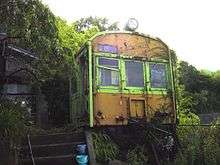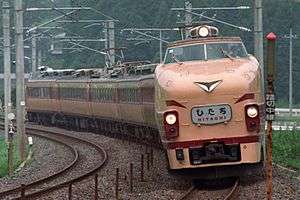72 series
| 72 series | |
|---|---|
|
A JNR 72 series train on the Kabe Line at Yokogawa Station in July 1984 | |
| In service | 1954–1985 |
| Manufacturer | JNR Niitsu Works, Hitachi, Kawasaki Heavy Industries, Kinki Sharyo, Kisha Seizō, Nippon Sharyo, Teikoku Sharyo, Tokyu Car |
| Replaced | 63 series |
| Constructed | 1952–1958 |
| Number built |
1,157 vehicles (total) 490 vehicles (72 series) 667 vehicles (conversions from 63 series) |
| Number preserved | 4 vehicles (as of November 2016) |
| Operator(s) | JNR (1954–1985) |
| Line(s) served | Various |
| Specifications | |
| Car length | 20 m (65 ft 7 in) |
| Maximum speed | 95 km/h (60 mph) (100 km/h (60 mph) for mail coach conversions) |
| Electric system(s) | 1,500 V DC |
| Current collection method | overhead catenary |
| Safety system(s) | Originally not fitted, later ATS-B and ATS-S |
| Track gauge | 1,067 mm (3 ft 6 in) |
The 72 series (72系) trains were DC electric commuter trains operated by Japanese National Railways (JNR), and served as the basis for the 101 series. The 72 series included the main production batch of 490 coaches as well as 667 former 63 series coaches converted into 72 series between 1953 and 1955. The last remaining trains were withdrawn in 1985, although some cars which were converted into mail coaches and experimental vehicles continued to remain in service until 1996.
Preserved examples

KuMoHa 73001 in Saeki, Hiroshima, June 2004
- KuMoHa 73001: Privately preserved in Saeki, Hiroshima. Restored in October 2013, awaiting move to Yanahara Fureai Mine Park.
- KuMoYa 90005: Stored at JR Central Hamamatsu Depot.
- KuMoYa 90801 (partial): Preserved at JR East Railway Museum (Saitama).
- KuMoNi 83006: Used at the Toshiba factory in Fuchu, Tokyo.
| Wikimedia Commons has media related to 72 series. |
This article is issued from Wikipedia - version of the 11/23/2016. The text is available under the Creative Commons Attribution/Share Alike but additional terms may apply for the media files.

